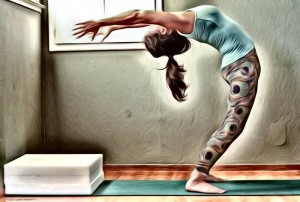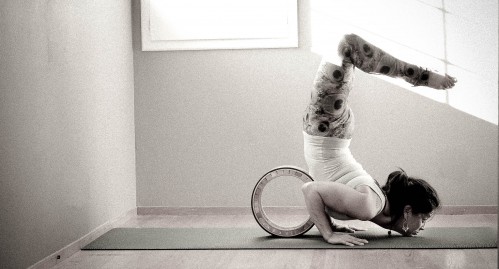Blog
Morning Chant
The morning chant is a special time in Mysore when the Ashtanga practitioners, who have been practicing independent of each other, come together for a few magical moments just as the sun has begun to rise. Like a choir in a HUGE cathedral, we sing the chant from deep within.
Sometimes, I can almost see the chant traveling around the world – offering peace and good intentions to everyone. And, today, I could also see it giving my son a little nudge to wake up and get out of bed: a far nicer way to wake up than that of the loud and annoying beep which he somehow has the ability to ignore.
when to split?
 When David Garrigues came to visit our yoga studio, he added Bakasana A & B, Bharadvajasana, and Ardha Matsyendrasana to my daily practice. These additional poses pushed my practice over the 2 hour mark. And although I have the ability to make time for it, the length of my practice has started to wear on me.
When David Garrigues came to visit our yoga studio, he added Bakasana A & B, Bharadvajasana, and Ardha Matsyendrasana to my daily practice. These additional poses pushed my practice over the 2 hour mark. And although I have the ability to make time for it, the length of my practice has started to wear on me.
Admittedly, I have been looking around the Mysore Room (on occasion) and noticed a few of my fellow ashtangis “splitting their practice.” Knowing that everyone’s practice is tailored, to a certain extent, to meet their needs, I figured that my teacher, Erika Abrahamian would let me know when I could also split off from primary before completing all of the poses and begin second.
Well, the desire to split my practice has been growing for some time now – and there has not been any indication from my teacher that a change would be coming. I began to wonder if there was a reason she wanted me to do all of the poses. I didn’t think it was to build endurance. I think I have shown that to her. Oh, but I AM tired. Perhaps I haven’t shown that outwardly, but indeed I am. Maybe, the reason she keeps me doing the entire primary plus all my given 2nd series poses has something to do with my hamstrings or my hypermobile joints. Whatever the reason: I didn’t know. To be honest, a part of me was afraid to ask. Yet, knowing the reason why would be helpful for me to continue on for from my perspective I have reached a point of “diminishing returns.”
I finally got up enough courage to ask about it. I told her that it was not that I didn’t have the time allotment, or the endurance. It was just that I am always sore and am often tired at the end of my practice. I told her that I tried easing up on the effort on alternating days by skipping vinyasas in the seated poses or not worrying about working the seemingly-impossible jump-back – without any change in my achiness. If anything, I was even more sore. I have since returned to working the jump-backs consistently. Now I am tired AND sore.
Well, guess what she said?
She said “okay.” I can move to Pasasana after Navasana, Supta Kurmasana, Baddha Konasana or after completing all of primary.
a different kind of year in review
After reading through random pages in my practice journal from the past 12+ months, I have come to realize a few things about my practice:
- I am always sore.
- Alignment is first and foremost on my mind.
- I have less of a tendency to measure my own progress by watching those around me.
- I no longer feel unimportant if I don’t get assisted in my practice.
- One eye in; one eye out is not impossible.
- Laziness is in the eye of the critic; I work hard and then bash myself for not working harder.
- Although I still cannot jump through or jump back, I have indeed made progress.
- No matter how sore I am, yoga always makes me feel better.
Bent Over Backwards

Sometimes I feel like I’ve done all I can to ease the pain — yet it continues. Finally, I realize that there is nothing left to do but just accept it. I’ve heard that Guruji said “Pain is inevitable and suffering is a choice.” It sounds so simple. Simple, it is NOT. It’s downright complicated and unpredictable. Sometimes I feel strong and flexible. Other times, I feel weak and feeble.
This past week, after having gone through the majority of my practice, waiting for the pain to melt away — yet it continued. As I got closer and closer to kapotasana, I wondered if I should just roll up my mat and call it a day. After all, it’s such an intense backbend. Instead of rolling it up, I proceeded with caution. My teacher came over to assist me, in my second attempt. A little unsure if I was up for the task, I gave her my hands and let her take me deeper into the pose. It was intense yet, when I came out of it, I was hit with a surprising sense of relief. I mean: my back pain was gone!
Every day is different.
I’ve been trying to allow for ease and leave room for doing a lighter practice when my body calls for it. Skipping vinyasa, not trying so hard to lift up and attempt to “float” back — and still I feel like the discomfort never lightens up. It’s so different from my marathoning days when a 20-mile run would be followed by a classic soreness but a 3 mile easy run would renew me. These days, even the rest days are followed with soreness. I wonder: Was it all an inevitable part of getting old? Or am I doing something wrong?
To be honest, I think if I could use that same mentality of acknowledging the inevitability of DOMS following each and ever practice, it would be easier to just accept it. And why not? Bending over backwards (coupled with everything leading up it) isn’t any easier than running 10 miles.
Right?
Modifications: Practice and Perception
Troubled by another health scare, I stepped foot on my mat praying for a little separation from the fear. Being a nurse, I knew the crazy facts of what could be should the CT scan confirm what might be. I could die any minute. Then again, can’t we all? I certainly know, from personal experience, that life has no guarantees. Life is precious and uncertain. We have no assurance that we will live a long, full life.
So I stepped to the front of my mat, put hands in front of my heart, and said a short prayer for the strength to take what ever news would come of the tests with strength and a positive outlook.
I hadn’t shared the physical findings of my examination, nor my doctor’s suspicions, with many. But I had shared it with my teacher who gave me her support and helped me to modify my practice to accommodate the feared diagnoses — just in case.
On my mat, I practiced cultivating ease and letting go of the notion that those deeps twists, intense backbends, and binds were the only way to find relief from the discomfort in my body. Of course this is always a good practice for me. Off the mat, I practiced staying in the present moment and finding separation from the worse-case-scenarios.
Initiating pranayama (breathing practices) while watching the IV get inserted into my vein and continuing the practice inside the CT scanner. I was amused when the scanner began cueing me, “Take a deep breath in. Stop your breathing…. Breathe.”
Before I knew it, the procedure was complete and the IV was being removed. I left the hospital exceptionally worn out — probably from a week of worry and deep discussions of what preparations I’ve made for end-of-life and what preparation I still need to attend to. Or perhaps it was just my body’s response to the IV contrast. I went home to drink lots of water, as instructed, and get some much needed sleep.
